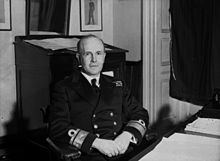Rank Admiral Service/branch Royal Navy | Name Cecil Harcourt Years of service 1904 - 1952 | |
 | ||
Commands held HMS WessexHMS StuartHMS PresidentHMS Duke of YorkHMS SheffieldHMS AuroraHMS CleopatraHMS VenerableHMS TamarHMS NewfoundlandHMS SwiftsureNore Command Battles/wars World War IWorld War II | ||
Battles and wars World War I, World War II | ||
Admiral Sir Cecil Halliday Jepson Harcourt (Chinese Translated Name: 夏慤; 11 April 1892 – 19 December 1959), was a British naval officer. From September 1945 to June 1946, Harcourt was the de facto governor of Hong Kong as commander-in-chief and head of the military administration. He was called by the Chinese name "Ha Kok", a reference to the fourth-century Chinese nobleman Chung Kok.
Contents
Biography
He was born in Bromley, London, son of Halliday Harcourt and Grace Lilian née Jepson. He had a distinguished career in the Royal Navy, which he entered as a midshipman on 15 September 1904, at the age of 12. He served in both world wars.
In 1939, he was appointed Director of the Admiralty's Operations Division. In 1941 he was Flag Captain of the Home Fleet, while commanding HMS Duke of York. From 1942 to 1944 he took part in the North Africa campaign, the capture of Tunisia, Pantelleria. Lampedusa and Sicily, and the landing at Salerno. In 1944 he became Naval Secretary. In 1945, he was Flag Officer Commanding 11th Aircraft Carrier Squadron, with his flag in HMS Colossus.
He became famous after he personally took the surrender of Japanese forces (under Vice-Admiral Fujita and Lieutenant-General Tanaka) in Hong Kong. He became the head of a provisional military government in Hong Kong from September 1945 to April 1946, serving as administrator until civilian rule could be established. He was knighted during this time, in December 1945.
In 1947, Harcourt became Flag Officer (Air) and Second in Command Mediterranean Fleet. In 1948, he became Second Sea Lord and Chief of Naval Personnel as well as a Lord Commissioner of the Admiralty, and in 1950 Commander-in-Chief, The Nore. He retired in 1952.
Ships he commanded
Ships under Harcourt's command included:
Private life
On 17 April 1913, he assumed the surname "Harcourt-Morris", but this lasted only a short time.
In 1920 he became the second husband of the English pianist Evelyn Suart, a widow. They had no children of their own. One of her daughters by her first marriage was the noted ballerina Diana Gould, who later became the second wife of the violinist Yehudi Menuhin. Her sister Griselda became the second wife of the pianist Louis Kentner. After Evelyn Suart's death in 1950, Harcourt married Stella, widow of Air Commodore David Waghorn, in 1953.
Honours
Places named after him
Harcourt Road, a main road in Hong Kong Island, and Harcourt Garden are named after him.
